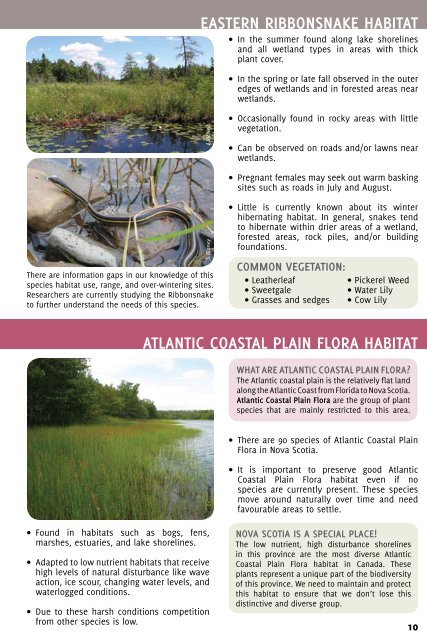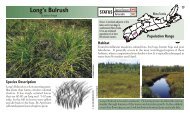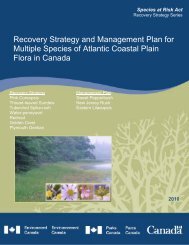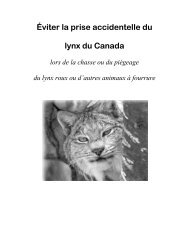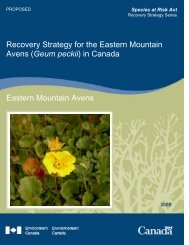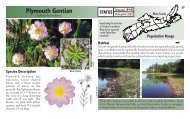Healthy Lakes and Wetlands For Tomorrow - Species at Risk
Healthy Lakes and Wetlands For Tomorrow - Species at Risk
Healthy Lakes and Wetlands For Tomorrow - Species at Risk
Create successful ePaper yourself
Turn your PDF publications into a flip-book with our unique Google optimized e-Paper software.
EASTERN RIBBONSNAKE HABITAT<br />
• In the summer found along lake shorelines<br />
<strong>and</strong> all wetl<strong>and</strong> types in areas with thick<br />
plant cover.<br />
• In the spring or l<strong>at</strong>e fall observed in the outer<br />
edges of wetl<strong>and</strong>s <strong>and</strong> in forested areas near<br />
wetl<strong>and</strong>s.<br />
Occasionally found in rocky areas with little<br />
•<br />
veget<strong>at</strong>ion.<br />
J. McNeil<br />
Can be observed on roads <strong>and</strong>/or lawns near<br />
•<br />
wetl<strong>and</strong>s.<br />
Pregnant females may seek out warm basking<br />
•<br />
sites such as roads in July <strong>and</strong> August.<br />
There are inform<strong>at</strong>ion gaps in our knowledge of this<br />
species habit<strong>at</strong> use, range, <strong>and</strong> over-wintering sites.<br />
Researchers are currently studying the Ribbonsnake<br />
to further underst<strong>and</strong> the needs of this species.<br />
S. Blaney<br />
• Little is currently known about its winter<br />
hibern<strong>at</strong>ing habit<strong>at</strong>. In general, snakes tend<br />
to hibern<strong>at</strong>e within drier areas of a wetl<strong>and</strong>,<br />
forested areas, rock piles, <strong>and</strong>/or building<br />
found<strong>at</strong>ions.<br />
Common Veget<strong>at</strong>ion:<br />
• Le<strong>at</strong>herleaf<br />
• Sweetgale<br />
• Grasses <strong>and</strong> sedges<br />
• Pickerel Weed<br />
• W<strong>at</strong>er Lily<br />
• Cow Lily<br />
ATLANTIC COASTAL PLAIN FLORA HABITAT<br />
Wh<strong>at</strong> are Atlantic Coastal Plain Flora<br />
The Atlantic coastal plain is the rel<strong>at</strong>ively fl<strong>at</strong> l<strong>and</strong><br />
along the Atlantic Coast from Florida to Nova Scotia.<br />
Atlantic Coastal Plain Flora are the group of plant<br />
species th<strong>at</strong> are mainly restricted to this area.<br />
There are 90 species of Atlantic Coastal Plain<br />
•<br />
Flora in Nova Scotia.<br />
Found in habit<strong>at</strong>s such as bogs, fens,<br />
•<br />
marshes, estuaries, <strong>and</strong> lake shorelines.<br />
• Adapted to low nutrient habit<strong>at</strong>s th<strong>at</strong> receive<br />
high levels of n<strong>at</strong>ural disturbance like wave<br />
action, ice scour, changing w<strong>at</strong>er levels, <strong>and</strong><br />
w<strong>at</strong>erlogged conditions.<br />
Due to these harsh conditions competition<br />
•<br />
from other species is low.<br />
M. Crowley<br />
• It is important to preserve good Atlantic<br />
Coastal Plain Flora habit<strong>at</strong> even if no<br />
species are currently present. These species<br />
move around n<strong>at</strong>urally over time <strong>and</strong> need<br />
favourable areas to settle.<br />
Nova Scotia is a Special Place!<br />
The low nutrient, high disturbance shorelines<br />
in this province are the most diverse Atlantic<br />
Coastal Plain Flora habit<strong>at</strong> in Canada. These<br />
plants represent a unique part of the biodiversity<br />
of this province. We need to maintain <strong>and</strong> protect<br />
this habit<strong>at</strong> to ensure th<strong>at</strong> we don’t lose this<br />
distinctive <strong>and</strong> diverse group.<br />
10


